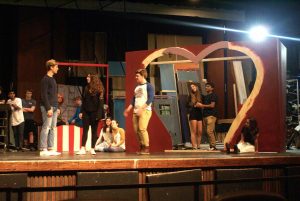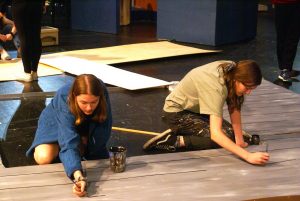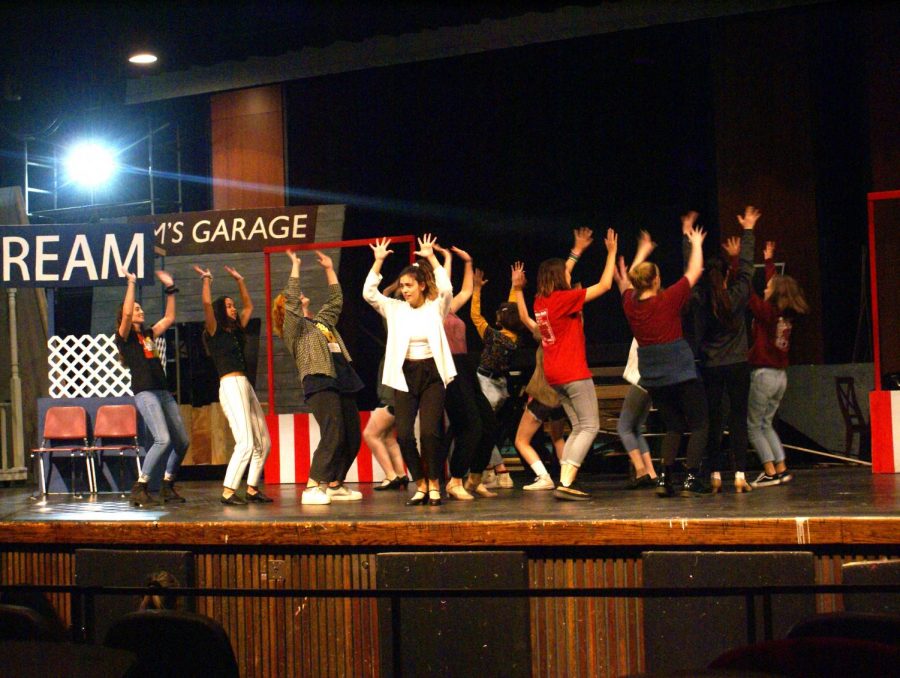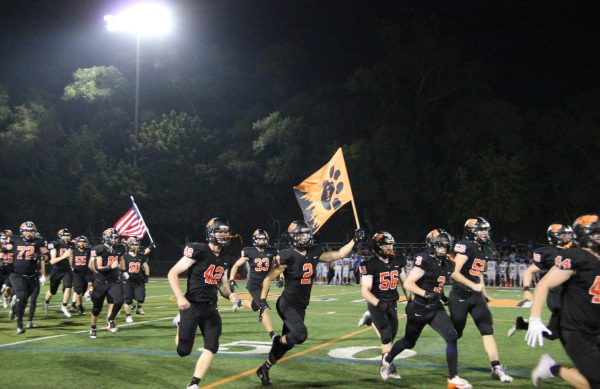Shaking up the stage
This musical includes many complicated dance sequences that involve a lot of people. By rehearsing these dances, it looks almost effortless.
The spotlight turns on, shining on a single actor on the stage. The student in charge of the lights holds the massive spotlight steady. Music plays, cued up by the crew in the sound booth, trained when to play it at exactly the right time. The actor says their lines and sings the opening number, followed by a roaring start of string and wind instruments down in the pit. The lights fade to black. The crowd erupts with applause. As they roar, the backstage crew scrambles behind the curtain as they pull it closed, changing the intricate set and rolling out the elaborate props. Meanwhile, the dance ensemble hurries into formation after the crew quickly clears out. Lights on. Curtains back. It’s go time.
This year, the fall musical is “All Shook Up,” a show inspired by Shakespeare’s “Twelfth Night” but also based around a number of Elvis Presley’s songs, including hits like “Blue Suede Shoes,” “Jailhouse Rock” and “Hound Dog.” The music in this show is a critical component to the story and there is music virtually from start to end.
The show follows the main character, Chad, played by senior Albert Sterner, navigating his way through the Midwest in the 1950s after being released from prison. The character finds himself in a small town where he meets a young mechanic named Natalie, played by junior Rachel Erdmann, and Chad proceeds to shake up the community’s uninspired way of life.
“All Shook Up” will be shown on two weekends this year in the LHS Auditorium. It can be seen on Oct. 26 at 7:30 p.m. and 27 at 2 p.m., as well as the following weekend, on Nov. 1 and 2, at 7:30 p.m. Tickets are $5 for adults and $4 for students.
The show has 42 students in the cast, which is fairly large compared to most other performances at LHS. The students in the production have been hard at work since the second week at school, making sure that everything comes together and is perfected by opening weekend.

“When everything comes on stage, and everything comes into place, it’s so beautiful. It’s like one big puzzle, and we get to see all of the little pieces as they’re coming together,” said the stage manager, senior Maja Gavrilović.
As stage manager, Gavrilović helps to run rehearsals and watches the performance in the booth. In the booth, she helps to make sure that light and sound cues go smoothly, as well as making sure props come on at the right time.
In the wings of the stage are Gavrilović’s two assistant stage managers, who make sure everything goes well and the actors and crew have what they need.
“We don’t necessarily get the most recognition because people don’t see our faces, but we know that we’re the ones who make the show run,” said junior Kate Barry, one of the assistant stage managers.
“When people are watching a scene from the audience, [they] see the actors play their role. But if you’re backstage and watching it, you’re watching to make sure that someone moves their prop at the right time and that platform is still where it needs to be. You notice different things and pay attention to the details,” Barry added.
The work that the actors do to prepare for opening night also takes a lot of time and practice.
“What I love most in the whole process is going through the text and making it my own, not just what the author wants to say but also how I can make the words something that can relate to the audience and relate to me,” she said.
Erdmann said she uses a technique that her theater director taught her, where she goes through the script and identifies her character’s objective, super objective and the tactics the character uses. The objective is the character’s goal for that scene, the super objective is the character’s goal for the entire show and the tactics are the little things that the character uses to achieve their goals.
“[The technique] allows me to really dig into the script and discover what my character wants. It makes me think ahead and think about what the scene means in the grand scheme of things. Once I can figure out what the scene means, then I can really master it and portray that goal,” Erdmann explained.
The character’s costumes and what they wear from scene to scene is also a big factor in how the production looks and feels. Senior Jordan Erdal is the head of costume crew and helps the actors behind the scenes during performances.
In the weeks leading up to the show, Erdal fits the actors for their costumes and creates pieces needed to fit the show’s theme. During the show, however, she’s organizing the costume racks and assisting actors who have to make quick changes.
“We do have a small number of people on costume crew, but I love them. They’re like my family. I’ve known them for the past three years. We spend a lot of time together down in the costume shop,” said Erdal.

Avery and Paige Vang are in charge with painting the little details of the set. These details help make the scenery look more realistic.
Aside from those physically backstage, the tech crew up in the booth also works extremely hard, making sure all of their equipment has been troubleshooted and is ready for opening night.
Senior Ainsley Johnson is the head of sound, the person in the booth who controls the audio and the microphones the actors are using. The weeks leading up to the first show, Johnson works on wiping and reconstructing the soundboard.
“It’s on a preset currently for what the auditorium uses, and we just clear it all out and we start from scratch, basically rebuilding the inputs and outputs so the mics can be connected,” said Johnson.
“When we’re in that first practice of tech week (the final week of rehearsals before the show opens), we don’t know what’s going to go wrong. But then by the end of the week, we have a beautiful production and just seeing that is absolutely incredible,” Johnson explained.
A part of the cast and crew’s job is not only to make everything run smoothly during the show but also to fix problems that arise mid-performance.
“The most challenging thing is when something goes wrong, and we have to think on the fly, and we have to improvise. For example, if an actor moves the wrong way, that can completely mess up the light cues. You have to think, ‘Can we go back? How can we fix it so that it’s not noticeable to the audience that something is wrong?’” described Gavrilović. She added that it’s the crew’s job to “make it look like everything’s going perfectly.”
Because of the large number of people in the cast, blocking and choreographing scenes for the show has been more difficult than usual.
Senior Michelle Hogarty is the dance captain for the show, as well as a member of the ensemble. Hogarty works with Mrs. Eryn Brown, a dance teacher at LHS, and Mr. Christopher Thomas, the theater director, to choreograph the musical numbers.
However, since the show is very music-based, the dance numbers that Hogarty choreographs also have to include space for other actors to say their lines and ways for cast members to carry props onstage.
“I’m not just focusing on the dance and the way that I want it to look. I have to think about how someone is going to bring a set piece in, but how can I still make that look like a dance? Or where I want the focus to be, so that we can highlight certain people or highlight certain set pieces, which isn’t something that I have had to think about before,” said Hogarty.
When the curtains close and the lights go out, the running crew comes on stage to move the bigger set pieces. The assistant stage managers, either assigned to the left or right side of the stage, are in charge in those situations.
“I tell people what needs to be moved off or on the stage during the show because there’s gotta be someone to make sure everything’s moving together,” said Barry, who is in charge of Stage Left. Barry explained that this is what she does for the majority of the show, but if running crew “needs another person, then I’m out there doing it with them.”
One thing that many of the crew members noted as something different about this production compared to others done in the past is the amount of moving parts and set pieces in “All Shook Up.” This show has a real motorcycle, a school bus built for the characters to sit in, a jukebox that plays music, and a rotating set piece called the Honky Tonk that can rotate to show two different backdrops.
The stage and set pieces around the actors tell just as much of a story as the songs and script. Lots of planning and constructing is done during the weeks leading up to the show to create meticulous set pieces that add to the performance.
Twin sisters Paige and Avery Vang have been on crew since freshman year, painting backdrops and set pieces.
Now juniors, they are the heads of paint, working after rehearsals with those on the set construction crew and other artists to design the sets. The Vangs explained that they are currently working on painting canvases to look like wood paneling and also creating lots of signs for a carnival scene in the show.
Paige stated that her favorite part about participating in the musical is “the community that you feel within the crew. Just going [to rehearsal] and seeing all of your close friends in one spot and being able to just work hard with all of them for two and a half hours a day is just refreshing.”
The cast and crew have a number of pre-show traditions that stand out to the students involved, greatly contributing to the family atmosphere. Johnson explained how, before the show, the crew members gather around on the stage and toast to a great show with sparkling cider.
“We wish everyone good luck and we just come together and say, ‘This is our show. We’ve come this far. Not everything is going to go perfectly, but we just have to do our jobs, carry on, and have a good show,’” Johnson described.









